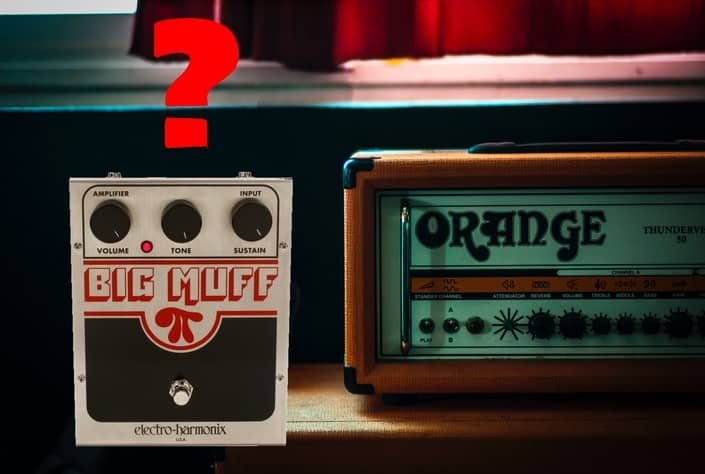
Fuzz pedals are awesome, but how do we get the best from them to suit our sound, style, and playing?
A common question I’m asked: “do fuzz pedals sound better through a ‘dirty’ or ‘clean’ amp?” This depends on your ideal fuzz tone: ‘subtle’, ‘heavy rhythm’, ‘ in your face’ or ‘screaming lead’ tones!
The fuzz pedal you are currently rocking will also be a big factor, varying in shape, sound, nuance, distortion, responsiveness, and tone.
Not to mention as the individual player you are, knowing what you want and what “sounds good” to your ears is important. First, it would be useful to define the sound differences between both amp types.
What’s a ‘Clean’ and ‘Dirty’ Amp?
Dirty amp: a distorted crunchy tone with a good amount of dirt and saturation (gritty dirty rock tone!)
Clean amp: clean and defined sound, something you would use for funk, country, and blues.
What Sounds Best?
Now, in my opinion, fuzz pedals sound much better when combined with a dirty amp tone. Why is this? Because fuzz pedals were always designed to be played loud with heaps of distortion especially when using it for lead playing.
There is something special about a dirty sound combined with a fuzz that creates a special mix of dynamics, especially for single note lead playing.
Fuzz can also be used for heavy styles of music for rhythm playing as the fuzz tone is a loose and heavy form of distortion compared to the standard tight amp distortion.
Using a cleaner amp tone combined with a subtle fuzz (mimicking an overdrive) can push the tone into a gentle overdrive boost instead of an ‘in your face’ wall of sound tone.
It also depends on the fuzz pedal you are using. If the pedal has enough gain and distortion to take a subtle clean tone and drive it to an oversaturated tone then the clean and dirty amp settings are not as important.
Most modern fuzz pedals have enough distortion to drive a tame clean tone to a filthy snarling fuzz tone.
On the other hand, the amount gain is something to be wary of, stacking too much distortion will oversaturate the tone causing a loss of definition and punch burying the sound in the mix.
Having a dirty amp tone is also going to allow for tons more sustain which is what all lead players desire.
The Best Amp for Fuzz Pedals?
Obviously, it’s not recommended to buy an amp based purely on how well it combines with fuzz.
As when it comes to your sound, there are more factors to consider such as your genre, your style, your sound
Knowing what amp and fuzz pedal combinations work well, however, will help when it comes to optimal tone. It’s the difference between having a fuzz tone that gets lost in a band mix or cuts through with all its creamy fuzzy goodness.
There is also no right or wrong answer when it comes to fuzz and amps, as it comes down to your personal preference what sounds good to your ears.
However, an amp that combines well with fuzz, in my opinion, will need to include the following criteria:
- Achieve distortion break-up with minimal volume
- Not an overly compressed sound
- No excessive headroom
- Include warm and natural distortion (usually from a tube amp)
- Handles bottom end well
- Good tone from the amp with minimal EQ and additional pedals
- Good tone that compliments the fuzz pedal tone
- Combines well with other pedals
Which Amps?
There are many amps out there to discuss, but darker sounding amps of the British variety ie. ‘Marshall’, ‘Orange’, and ‘Hi-Watt.’
Have known to combine better with more aggressive sounding fuzz pedals tonally due to the low-end and pronounced mid-range frequencies.
To get the best out of your fuzz, you will need an amp that can easily achieve a warm, crunchy dirty tone on the verge of break up without having to crank the volume.
This gives a good foundation for
Therefore, when trying amplifiers, knowing the sound and how well it breaks ups and the amount of headroom it allows is a good characteristic to look for.
What Wattage?
So when it comes to break-up, valve amps with a lower wattage (around 20 watts) would be better than a 100-watt amp with buckets of headroom.
This means that Fender clean amps are not the best candidates for a wall of sound tone, due to the high amounts of headroom and scooped mid tone and excessive compression.

An amp with an over-compressed sound combined with a fuzz will sound fizzy, nasty and too harsh on the ears.
A subtle overdriven fuzz pedal would suit this kind of amp but when it comes to filthy distortion tones these amps are not the best choices. Clean amps would suit a more subtle fuzz resembling overdrive to get a nice warm and creamy vintage lead tone.
What The Fuzz!
Knowing what tones to expect from your fuzz pedal and how to combine it with the amp is also a big factor.
For example, the ‘Germanium Fuzz Face’ tonally resembles more of an overdriven tone whereas the more aggressive in your face Big Muff sounds closer to angry distortion.
So doing your homework with your pedals and how you tend to benefit using it with your amp is important.
This means that not all fuzz pedals will sound good when plugged in, they will require some EQ twiddling.
Fuzz Pedal on Clean or Lead Channel?
Keep in mind, as you (the individual guitar player), there’s no right or wrong on how to set your pedals! it all depends on your preference and what sounds you want to get out of your delicious fuzz pedal.
However, when it comes to pedals and what channel to run them through if you own a two channel amp, there are some typical guidelines to follow.
Lead Channel
The lead or ‘dirty’ channel, mainly serves to produce the majority of your sounds distortion regardless of any pedals.
Meaning that distortions, overdrives, and fuzz pedals are meant to act as a subtle boost to add an extra characteristic to your amps sound and tone.
Therefore, running a fuzz pedal through the lead channel would be best utilized for a screaming, high-gain and juicy ‘in your face’ lead tone, functioning as a distortion boost for solos and lead playing.
typically most distortion and overdrive pedals suit running stacked through a lead channel with a dirty amp, as it compresses and tightens up the sound better than the clean channel.
Although I can’t speak for most amps, this is generally the case with twin channel tube amps.
Bethe dirty channel will also result in more gain and when combined with a fuzz, will be enough saturation and distortion to optimize what a fuss is meant to be utilized as… a fat and monstrous ‘in your face’ sound.
This is the best option if you desire to use your fuzz as a lead tone machine.
Clean Channel
Now when it comes to the clean channel, you run a pedal through the clean channel to get most of your distortion sound from the pedal and not the amp.
There are many distortion pedals that function as amp simulators such as the ‘Pinnacle Standard Travis’ which sound better through the clean channel for the purpose of avoiding using your amps distortion as your main dirty tone.
For a fuzz pedal, it can be used for a beefy and mid-distorted rhythm tone as your main sound when
There’s no saying you could not use it as your lead tone also if your fuzz pedal includes enough distortion.
It has to be said that this set-up has the added benefit of a clean tone with your amps EQ and a dirty tone with your fuzz pedals EQ for added flexibility.
It also means you have a quick dirty to clean using your pedal similar to an amp’s clean to lead channel selector switch for quick tone changes.
Another situation is if you owned an amp and liked the clean tone but not keen on the dirty channel (lacks, dirt, bite or character for example) running a distortion pedal through the clean channel can then act as your main sound.
Run a Fuzz Pedal in the Effects Loop?
Running a fuzz pedal in your amps effects loop means you are bypassing the front of the amp (preamp section) and mainly using the power section from your pedal board.
Usually, fuzz, drives and distortion pedals are placed in front of the amp before the pre-amp section which makes sense, as this is where your pedals can push the tubes to create additional grit, dirt, and juicy distortion.
The amps tubes are in the preamp section which is where you get most of your distortion tone from.
The effects loop is mostly reserved for modulation (chorus, flanger) and time-based effects pedals (reverb and delay). This is because these effects can typically skip the preamp section.
However, there are some reasons why guitar players run distortion, drives or a fuzz pedals in the effects loop.
A situation would be if you were a touring gigging guitarist which happened to rent amplifiers for shows, say if you did not like the distortion from the amp and your pedal board is your main sound.
Bypassing the preamp section and using your pedal board to the power section can add more flexibility and means you are not at the mercy of your amplifiers distortion tone.
Keep in mind, not all effects loops are built equally, sometimes running distortion through the effects loop can result in a fizzy and harsh sound almost like the sound is being produced from a tiny 5” speaker.
Typically fuzz pedals are designed to be first in the chain due to the way how your guitar’s pickups load into it.
For getting the most out of your fuzz, I would suggest putting it in front of your amp where it is usually best utilized for optimal sound and tone but there’s no harm in experimenting.
Final Thoughts
Clearly, there’s a lot of thought when it comes to getting the best from a fuzz pedal! There’s no pedal that you can just throw in front of any amp and expect a great tone.
As versatile as fuzz pedals are, knowing how to use it can get the best and sweetest tones available for your playing. Hopefully, this post has given you some insight into fuzz and amplifiers and served as an interesting and informative read.
